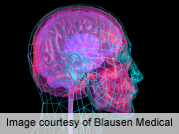
WEDNESDAY, April 11 (HealthDay News) — A new nonsurgical method for monitoring brain pressure might help improve treatment of head injury patients, according to a new study.
Head injuries, including concussions, and brain tumors can lead to increased pressure inside the skull, which can crush brain tissue or cut off the brain’s blood supply.
Monitoring brain pressure can help doctors determine the best treatment for these patients. However, this requires drilling a hole in the skull so it is done only in the most serious cases. Risks include infection or damage to the brain, study co-author George Verghese, a distinguished professor of electrical engineering at MIT, said in an institute news release.
This new method is much less invasive and may enable doctors to measure brain pressure in patients who have milder head injuries, but would benefit from close monitoring, the MIT researchers said.
“It’s still at the validation stage. To convince people that this works, you need to build up more [data] than we currently have,” Verghese said.
They developed a technique based on a computer model of how blood flows through the brain. The researchers found that they can calculate brain pressure from two less-invasive measurements: arterial blood pressure and an ultrasound measurement of how quickly blood flows through the brain.
This approach enables changes in brain pressure to be monitored over time so that doctors can detect problems that might develop gradually, the researchers said.
They describe the technique in the April 11 issue of the journal Science Translational Medicine.
“It’s a holy grail of clinical neurosurgery to find a noninvasive way to measure (brain) pressure,” James Holsapple, chief of neurosurgery at Boston Medical Center, said in the news release. “It would be a big step if we could get our hands on something reliable.”
He said the MIT technique shows promise and added that the next major step is to incorporate the technology into a system that’s easy for hospital staff to use and that can record data over many hours or days.
More information
The Brain Injury Association of America has more about brain injury treatment.

